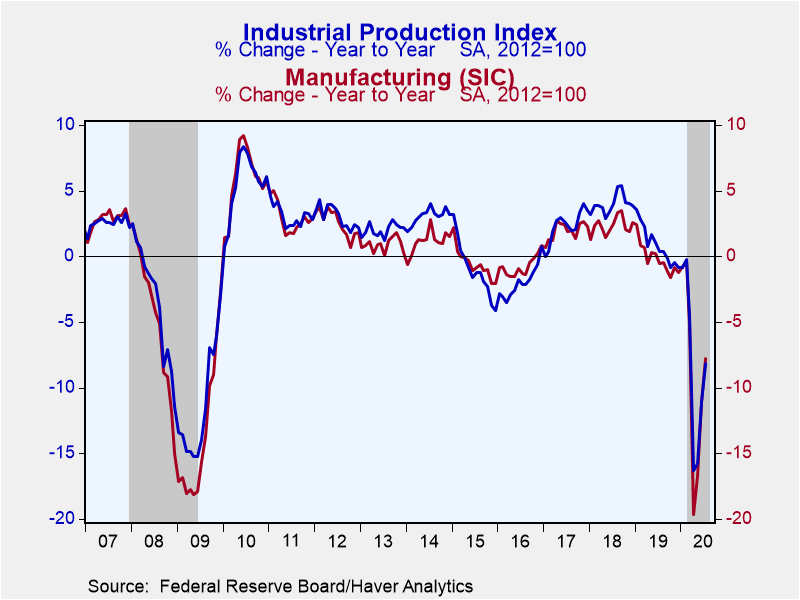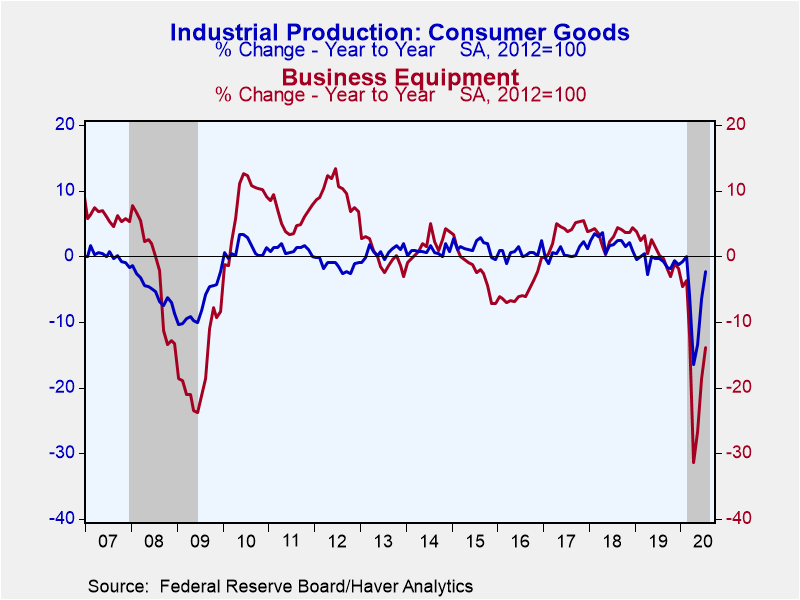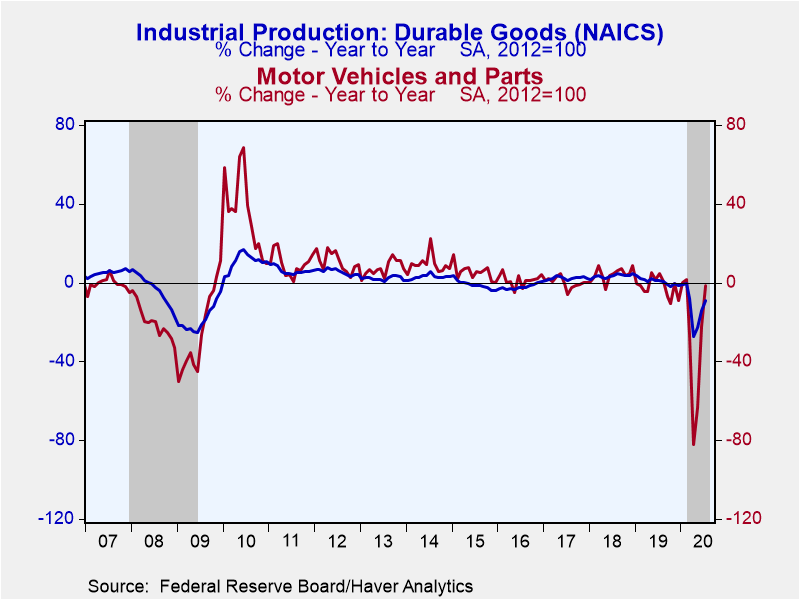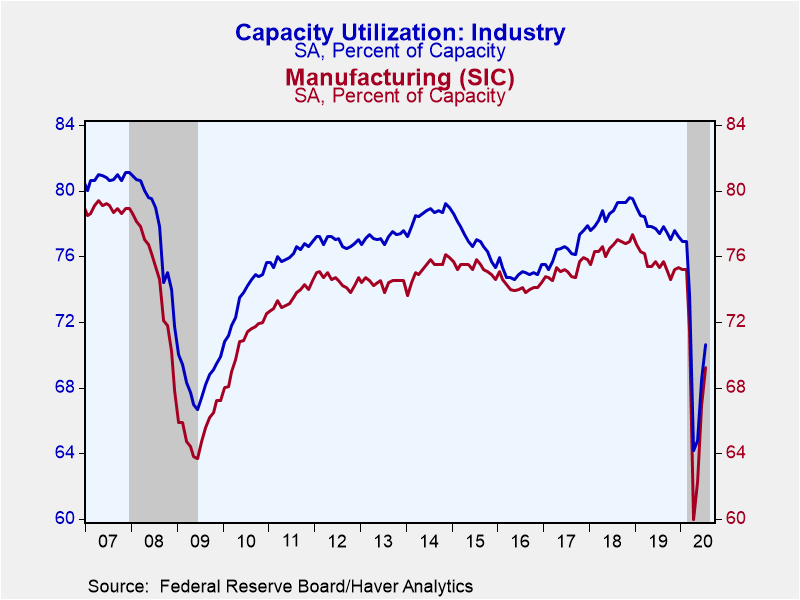 Global| Aug 14 2020
Global| Aug 14 2020U.S. Industrial Production Continues Rebound in July
by:Sandy Batten
|in:Economy in Brief
Summary
• Manufacturing output gains were again broad-based in July though smaller than in June. • Even with three monthly gains, total industrial production still 8.4% below pre-Covid peak. • Another strong gain in auto output to nearly pre- [...]
• Manufacturing output gains were again broad-based in July though smaller than in June.
• Even with three monthly gains, total industrial production still 8.4% below pre-Covid peak.
• Another strong gain in auto output to nearly pre-Covid level.
Industrial production increased 3.0% m/m (-8.2% y/y) in July following an upwardly revised 5.7% m/m gain in June (initially +5.4%) and a 0.9% m/m rise in May. Even with the three consecutive monthly increases, IP remains 8.4% below its pre-Covid February level. The July reading was spot on the 3.0% rise expected by the Action Economics Survey.
Manufacturing production gained 3.4% m/m (-7.7% y/y) in July after rising an upwardly revised 7.4% in June. Most major industries posted increases though they were smaller than in June. Output of durable goods rose 5.5% m/m (-9.3% y/y) following a 11.9% m/m jump in June. The rebound continued to be led by surging motor vehicle production that had been decimated by the pandemic. Motor vehicles production increased 28.3% m/m (-1.4% y/y) on top of a 118.3% rise in June and a 111.0% gain in May These three outsized monthly gains have pushed motor vehicle output up to nearly its pre-Covid February level. Apart from motor vehicle production, the rest of factory output rose 1.6% m/m in July. Output of business equipment, an indicator of capital spending, increased 5.0% m/m (-13.9% y/y) in July, its third consecutive monthly increase, but is still 11% below its pre-Covid level.
The index for nondurables rose 1.3% m/m (-5.4% y/y) in July, a slowdown from the 3.5% gain in June. The July gain was led by more than 3% m/m increases in textile and product mills, printing, and petroleum products.
After having decreased for five consecutive months, mining output edged up 0.8% m/m (-17.0% y/y) in July. The output of utilities increased 3.3% m/m (+0.6% y/y) as warmer than usual temperatures increased the demand for air conditioning.
Capacity utilization rose to 70.6% in July from a downwardly revised 68.5% in June (initially 68.6%). This slightly exceeded the Action Economics Survey which had looked for capacity utilization to increase to 70.4%. Factory sector utilization increased to 69.2% in July from an unrevised 66.9% in June.
Industrial production and capacity are located in Haver's USECON database. Additional detail on production and capacity can be found in the IP database. The expectations figures come from the AS1REPNA database.
| Industrial Production (SA, % Change) | Jul | Jun | May | Jul Y/Y | 2019 | 2018 | 2017 |
|---|---|---|---|---|---|---|---|
| Total Output | 3.0 | 5.7 | 0.9 | -8.2 | 0.9 | 4.0 | 2.3 |
| Manufacturing | 3.4 | 7.4 | 3.8 | -7.7 | -0.2 | 2.3 | 2.0 |
| Durable Goods | 5.5 | 11.9 | 6.9 | -9.3 | 0.7 | 3.4 | 2.2 |
| Motor Vehicles | 28.3 | 118.3 | 111.0 | -1.4 | -2.3 | 4.1 | 0.0 |
| Selected High Tech | 1.6 | 2.1 | -0.3 | 4.6 | 5.1 | 6.4 | 2.6 |
| Nondurable Goods | 1.3 | 3.5 | 1.3 | -5.4 | -0.7 | 1.9 | 1.9 |
| Utilities | 3.3 | 2.0 | -0.5 | 0.6 | -0.8 | 4.4 | -0.8 |
| Mining | 0.8 | -0.3 | -11.3 | -17.0 | 7.1 | 12.4 | 7.4 |
| Capacity Utilization (%) | 70.6 | 68.5 | 64.8 | 77.4 | 77.8 | 78.7 | 76.5 |
| Manufacturing | 69.2 | 66.9 | 62.3 | 75.3 | 75.6 | 76.6 | 75.1 |
Sandy Batten
AuthorMore in Author Profile »Sandy Batten has more than 30 years of experience analyzing industrial economies and financial markets and a wide range of experience across the financial services sector, government, and academia. Before joining Haver Analytics, Sandy was a Vice President and Senior Economist at Citibank; Senior Credit Market Analyst at CDC Investment Management, Managing Director at Bear Stearns, and Executive Director at JPMorgan. In 2008, Sandy was named the most accurate US forecaster by the National Association for Business Economics. He is a member of the New York Forecasters Club, NABE, and the American Economic Association. Prior to his time in the financial services sector, Sandy was a Research Officer at the Federal Reserve Bank of St. Louis, Senior Staff Economist on the President’s Council of Economic Advisors, Deputy Assistant Secretary for Economic Policy at the US Treasury, and Economist at the International Monetary Fund. Sandy has taught economics at St. Louis University, Denison University, and Muskingun College. He has published numerous peer-reviewed articles in a wide range of academic publications. He has a B.A. in economics from the University of Richmond and a M.A. and Ph.D. in economics from The Ohio State University.










